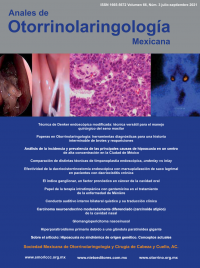
Role of intratympanic gentamicin for management of Ménière’s disease.
An Orl Mex. 2021; 66 (3): 220-228. https://doi.org/10.24245/aorl.v66i3.5227
Gabriela Ramírez-Arroyo, Edna Carrillo-Pacheco
Servicio de Otorrinolaringología y Cirugía de Cabeza y Cuello, Instituto Nacional de Rehabilitación Luis Guillermo Ibarra Ibarra, Ciudad de México.
Resumen
ANTECEDENTES: La enfermedad de Ménière es un síndrome clínico caracterizado por ataques de vértigo espontáneo, que se asocia con hipoacusia neurosensorial fluctuante, acúfeno y plenitud aural. Su diagnóstico se basa en los criterios de la Sociedad Bárány. Del 10 al 20% de los pacientes con enfermedad de Ménière tienen vértigo intratable, las alternativas de tratamiento en estos casos son la cirugía del saco endolinfático, infiltración intratimpánica de gentamicina, neurectomía vestibular y laberintectomía.
CASO CLÍNICO: Paciente femenina de 62 años con enfermedad de Ménière bilateral, quien tenía vértigo incapacitante que no respondía a cambios en el estilo de vida ni al tratamiento con betahistina, diuréticos o esteroide. Para el tratamiento del vértigo intratable, se realizó infiltración intratimpánica con gentamicina en agosto de 2016. Posterior a esta infiltración, la paciente no ha tenido crisis de vértigo en tres años y la discriminación fonémica se ha mantenido estable. Como parte de un tratamiento integral, la paciente recibió rehabilitación vestibular, se adaptó un auxiliar auditivo y se otorgó tratamiento por el servicio de psiquiatría. El manejo multidisciplinario mejoró la calidad de vida de la paciente.
CONCLUSIONES: Este caso clínico ejemplifica la administración de gentamicina intratimpánica como una alternativa terapéutica contra el vértigo intratable, incluso en el contexto de audición socialmente útil.
PALABRAS CLAVE: Enfermedad de Ménière; vértigo; gentamicina.
Abstract
BACKGROUND: Ménière’s disease is a clinical syndrome characterized by spontaneous vertigo attacks, associated with fluctuating neurosensorial hearing loss, tinnitus, and aural fullness. The diagnosis is based on the criteria proposed by the Barany Society. 10 to 20% of patients with Ménière’s disease have intractable vertigo, management alternatives in these cases are endolymphatic sac surgery, infiltration with intratympanic gentamicin, vestibular neurectomy, and labyrinthectomy.
CLINICAL CASE: A 62-year old female patient with bilateral Ménière’s disease presented with incapacitating vertigo that did not respond to lifestyle changes nor to treatment with betahistine, diuretics, or steroids. For management of intractable vertigo, the patient received intratympanic gentamicine in August, 2016. After the infiltration, the patient had not presented any vertigo crisis for 3 years and the phonemic discrimination has been stable. As part of a comprehensive medical care, she received vestibular rehabilitation, a hearing aid was adapted, and she received treatment by the psychiatry department. Multidisciplinary management improved quality of life in this patient.
CONCLUSIONS: This clinical case exemplifies the use of intratympanic gentamicin as a therapeutic alternative for intractable vertigo, even in the context of socially useful hearing.
KEYWORDS: Ménière’s disease; Vertigo; Gentamicin.
Recibido: 25 de enero 2021
Aceptado: 29 de julio 2021
Este artículo debe citarse como: Ramírez-Arroyo G, Carrillo-Pacheco E. Papel de la terapia intratimpánica con gentamicina en el tratamiento de la enfermedad de Ménière. An Orl Mex. 2021; 66 (3): 220-228.

